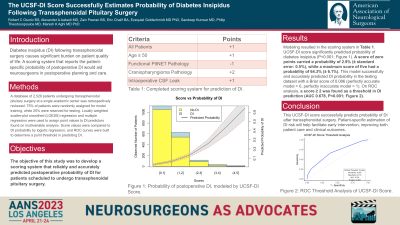The UCSF-DI Score Successfully Estimates Probability of Diabetes Insipidus Following Transsphenoidal Pituitary Surgery
Friday, April 21, 2023


Robert C. Osorio (he/him/his)
Medical Student
University of California San Francisco, Department of Neurological Surgery
San Francisco, California, United States
ePoster Presenter(s)
Introduction: Diabetes insipidus (DI) following transsphenoidal surgery causes significant burden on patient quality of life. A scoring system that reports the patient-specific probability of postoperative DI would aid neurosurgeons in postoperative planning and care.
Methods: A database of 2,529 patients undergoing transsphenoidal pituitary surgery at a single academic center was retrospectively reviewed. 75% of patients were randomly assigned for model training, while 25% were reserved for testing. Locally weighted scatter-plot smoothed (LOESS) regression and multiple regression were used to assign point values to DI predictors found on multivariable analysis. Score values were compared to DI probability by logistic regression, and ROC curves were built to determine a point threshold in predicting DI.
Results: Modeling resulted in the following scoring system (criteria found in a case are assigned a “one,” while absent criteria are assigned a “zero”): UCSF-DI Score = (patient age < 50) - (functional adenoma pathology) + 2*(craniopharyngioma pathology) + (intraoperative cerebrospinal fluid leak) + 1. One point was added to the model to arrive at a 0-5 point range. On regression analysis, UCSF-DI score significantly predicted probability of diabetes insipidus (P < 0.001). A score of zero points carried a probability of 2.9% (± standard error: 0.5%), while a maximum score of five had a probability of 64.3% (± 6.1%). This model successfully and accurately predicted DI probability in the testing dataset with a Brier score of 0.086 (perfectly accurate model = 0, perfectly inaccurate model = 1). On ROC analysis, a score ≥ 2 was found as a threshold in DI prediction (AUC 0.678, P< 0.001).
Conclusion : This UCSF-DI score successfully predicts probability of DI after transsphenoidal surgery. Patient-specific estimation of DI risk will help facilitate early intervention, improving both patient care and clinical outcomes.
Methods: A database of 2,529 patients undergoing transsphenoidal pituitary surgery at a single academic center was retrospectively reviewed. 75% of patients were randomly assigned for model training, while 25% were reserved for testing. Locally weighted scatter-plot smoothed (LOESS) regression and multiple regression were used to assign point values to DI predictors found on multivariable analysis. Score values were compared to DI probability by logistic regression, and ROC curves were built to determine a point threshold in predicting DI.
Results: Modeling resulted in the following scoring system (criteria found in a case are assigned a “one,” while absent criteria are assigned a “zero”): UCSF-DI Score = (patient age < 50) - (functional adenoma pathology) + 2*(craniopharyngioma pathology) + (intraoperative cerebrospinal fluid leak) + 1. One point was added to the model to arrive at a 0-5 point range. On regression analysis, UCSF-DI score significantly predicted probability of diabetes insipidus (P < 0.001). A score of zero points carried a probability of 2.9% (± standard error: 0.5%), while a maximum score of five had a probability of 64.3% (± 6.1%). This model successfully and accurately predicted DI probability in the testing dataset with a Brier score of 0.086 (perfectly accurate model = 0, perfectly inaccurate model = 1). On ROC analysis, a score ≥ 2 was found as a threshold in DI prediction (AUC 0.678, P< 0.001).
Conclusion : This UCSF-DI score successfully predicts probability of DI after transsphenoidal surgery. Patient-specific estimation of DI risk will help facilitate early intervention, improving both patient care and clinical outcomes.
